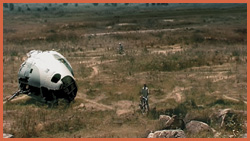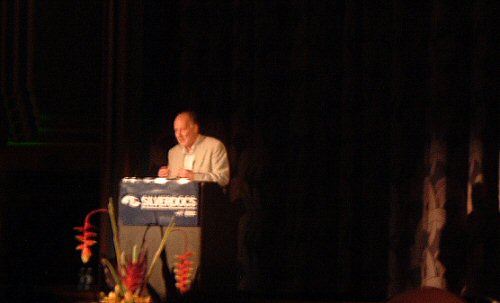June 25, 2005
Silverdocs Wrapup, Revisited
I know I promised a final Silverdocs wrapup a few days ago but I have had trouble working up the enthusiasm to rewrite it after losing the whole thing through a crack in cyberspace. So I will just post a few points here.
- Shorts. I like shorts. Possibly better than features. Because the short format is so useless commercially, it means there are no constraints on the artist and they are free to be as creative/weird/different as they want to be. So you’re far more likely to see something exciting and innovative when watching shorts than when watching features. That said, my favorite short at Silverdocs was Jay Rosenblatt’s Phantom Limb.
 Have you seen a Jay Rosenblatt film? They are not easy to see, but if you can, see some. Especially The Smell of Burning Ants. But his new one, Phantom Limb, is just as disturbing and emotionally wrenching as his others. There is one scene that I will remember for the rest of my life. The film is a meditation on the guilt he has felt his whole life over the death of his young brother when he was a child. Their parents never talked about it, and he thought it was his fault because he used to tease his brother. The film is very heavy and oppressive…until the sheep-shearing scene. I don’t know if you’ve ever seen a sheep sheared (I haven’t) but the sheep is sitting on its hind legs, held between the shearer’s legs as he bends over it and runs the clippers over it. The sheep struggles now and then. In the film, it is one extended take, in slow-motion, of the man shearing the sheep, as a woman in voiceover reads a long list of the stages of grief. It sounds simple, and it is, but I was sobbing by the time the scene was over. Sobbing. The shearing is certainly something the sheep doesn’t want done, but in this context, in slow-motion, with the grief stages being read in voiceover, it gives the impression of someone flailing and struggling with grief while someone holds them, caresses them, forcibly sloughs off their pain and baggage, revealing the pink and tender skin beneath. And the sheep finally totters off, naked and vulnerable, like someone who has been through a particularly gut-wrenching therapy session, newly sensitive to everything around him.
Have you seen a Jay Rosenblatt film? They are not easy to see, but if you can, see some. Especially The Smell of Burning Ants. But his new one, Phantom Limb, is just as disturbing and emotionally wrenching as his others. There is one scene that I will remember for the rest of my life. The film is a meditation on the guilt he has felt his whole life over the death of his young brother when he was a child. Their parents never talked about it, and he thought it was his fault because he used to tease his brother. The film is very heavy and oppressive…until the sheep-shearing scene. I don’t know if you’ve ever seen a sheep sheared (I haven’t) but the sheep is sitting on its hind legs, held between the shearer’s legs as he bends over it and runs the clippers over it. The sheep struggles now and then. In the film, it is one extended take, in slow-motion, of the man shearing the sheep, as a woman in voiceover reads a long list of the stages of grief. It sounds simple, and it is, but I was sobbing by the time the scene was over. Sobbing. The shearing is certainly something the sheep doesn’t want done, but in this context, in slow-motion, with the grief stages being read in voiceover, it gives the impression of someone flailing and struggling with grief while someone holds them, caresses them, forcibly sloughs off their pain and baggage, revealing the pink and tender skin beneath. And the sheep finally totters off, naked and vulnerable, like someone who has been through a particularly gut-wrenching therapy session, newly sensitive to everything around him.
 My pick for best of the fest would be the same as the jury’s pick: Darwin’s Nightmare. It is an incredibly upsetting film that exposes the way Europe (and Russia, but there didn’t seem to be any Americans) exploits Tanzania for its fish. Perch, to be exact. Tanzania on the one hand is glad that the foreigners want their fish–it’s brought jobs to the area. But the Tanzanians are still starving, they can’t afford the very fish they catch and sell to the foreigners, and the film gets into all of the intricate ways the fishing industry is exploiting and destroying the area. It is a political film that focuses on the small, intimate details more than the big ones: the young boys savagely fighting each other for a handful of rice, in a town overrun by rich Europeans taking fish from their waters. The mother who is grateful for her job of airing out decaying fish carcasses (while standing in a pool of mud and maggots). The prostitutes visited by European and Russian pilots. The prostitute who was killed by one of them. The children in the alleys sniffing glue made from melted fish packaging. It goes on and on and on.
My pick for best of the fest would be the same as the jury’s pick: Darwin’s Nightmare. It is an incredibly upsetting film that exposes the way Europe (and Russia, but there didn’t seem to be any Americans) exploits Tanzania for its fish. Perch, to be exact. Tanzania on the one hand is glad that the foreigners want their fish–it’s brought jobs to the area. But the Tanzanians are still starving, they can’t afford the very fish they catch and sell to the foreigners, and the film gets into all of the intricate ways the fishing industry is exploiting and destroying the area. It is a political film that focuses on the small, intimate details more than the big ones: the young boys savagely fighting each other for a handful of rice, in a town overrun by rich Europeans taking fish from their waters. The mother who is grateful for her job of airing out decaying fish carcasses (while standing in a pool of mud and maggots). The prostitutes visited by European and Russian pilots. The prostitute who was killed by one of them. The children in the alleys sniffing glue made from melted fish packaging. It goes on and on and on.
- A few tips from a panel called “Working the Festival Circuit”. First, and this was actually one tip I knew from working with the Boston Jewish Film Festival: don’t make a film that is 50 minutes to an hour long. It is an awkward length and is difficult to program at festivals. Make a short film or a feature. That said, festivals do often show some hour-long films, but it better be good if it’s going to be that length. A short film can be run in a shorts package or before a feature, but an hour-long film is not going to be run before a feature and is too long to be part of a shorts package. Something to consider. Another interesting point that came out of the panel was some concern among filmmakers that festival programmers get all their films from other festivals and rarely accept films that are blindly submitted, therefore when they send in their $50 submission fee, they are really only subsidizing the festival. This is a legitimate concern that was sort of dodged by the festival people on the panel. I spoke with a festival director later in the week, and he admitted that filmmakers should be concerned. But he added that every programmer would love to get a great film in the mail, submitted blindly. It just doesn’t happen often. This is an interesting issue to me because it is currently a controversial issue in the poetry world as well, where some poets are criticizing poetry contests that they say are “fixed”–you send in your submission fee but usually the prize goes to friends of the judges or well-known poets. There’s a whole website devoted to it.
 It seemed I gravitated toward foreign films at the festival, and among those there seemed to be a theme of divisions/walls/barriers. First there was Podul Peste Tisa, a Romanian film about a bridge between Romania and the Ukraine that was demolished by retreating Germans at the end of WWII and was never repaired, separating families for as much as 50 years. Some yell across the river to each other as their only form of communication. The film follows the saga of attempts to rebuild the bridge–so much red tape that the bridge, now built, is still closed and no one is allowed to cross. Another film about divisions/walls was Good Times, about the wall built by Israel in Abu Dis, a Palestinian village near Jerusalem. Again this is a political film that focuses on the minutiae: the old muslim women struggling to climb over the first incarnation of the wall which was short and crumbling, the Israeli soldiers haphazardly enforcing the barrier, at times joking with the crossing Palestinians, the shop owners who depend on business from people of both sides crossing the border, and, finally, the silence and desolation after a new 8-foot wall with no breaks is built to replace the old crumbling one.
It seemed I gravitated toward foreign films at the festival, and among those there seemed to be a theme of divisions/walls/barriers. First there was Podul Peste Tisa, a Romanian film about a bridge between Romania and the Ukraine that was demolished by retreating Germans at the end of WWII and was never repaired, separating families for as much as 50 years. Some yell across the river to each other as their only form of communication. The film follows the saga of attempts to rebuild the bridge–so much red tape that the bridge, now built, is still closed and no one is allowed to cross. Another film about divisions/walls was Good Times, about the wall built by Israel in Abu Dis, a Palestinian village near Jerusalem. Again this is a political film that focuses on the minutiae: the old muslim women struggling to climb over the first incarnation of the wall which was short and crumbling, the Israeli soldiers haphazardly enforcing the barrier, at times joking with the crossing Palestinians, the shop owners who depend on business from people of both sides crossing the border, and, finally, the silence and desolation after a new 8-foot wall with no breaks is built to replace the old crumbling one.
- Grizzly Man. I have surprisingly little to say about this one. I was very excited to see him in person, but I was not bowled over by the film. Treadwell is clearly insane, but I was a bit irritated with Herzog’s treatment of him. Herzog acted as if he knew the man inside and out, kept comparing him to Klaus Kinski on the set of Aguirre the Wrath of God, claimed Treadwell was related to Aguirre–it was as if Herzog was claiming ownership, or paternity, and lamenting his child’s silly attitude about nature, an attitude that got him killed, and if he only were as smart as Herzog he would have survived. But in reality, Treadwell did survive for 13 years with the Grizzlies. That fact is not felt in the film. And he did know exactly how dangerous it was, he said it many times, he told loved ones that if he never returned, it was what he wanted. He had mental problems and couldn’t handle the world of people, and if he wanted to die with the Grizzlies, who is Herzog to say that’s wrong? Or worse, to claim that he didn’t understand the danger of his situation? Herzog’s pursuit of Treadwell and his claims to understand him better than anyone else (his exact words), to have a special bond with him, are much like Treadwell’s claims to know and understand the Grizzly better than anyone else. And both are equally naive, I think. Both overly romanticize their subjects. Treadwell studies and tracks the Grizzly, Herzog studies and tracks what Tarkovsky called the “holy fool”. The film is more like a letter to Treadwell than a work of art, a bit didactic and over the top, and not the mysterious work of art that Herzog’s older documentaries like Land of Silence and Darkness are. Maybe as artists age they don’t have time any more for subtlety.
That’s all I can muster for now, but I’m sure I’ll have Silverdocs spasms here and there in the near future.
 Filed by cynthia rockwell at 6:49 am under Just Movies,Silverdocs
Filed by cynthia rockwell at 6:49 am under Just Movies,Silverdocs
 4 Comments
4 Comments

you once said that you don’t like documentaries that just bring you the truth. that you might as well read it in a magazine. that you want some artistic merit too. but doesn’t a documentary that really shows you what’s going on bring it in a way that a magazine just can’t?
maybe i misunderstood you that other time.
yeah a documentary can do that. and you didn’t misunderstand me, though there is a difference between a news journalism-type documentary and one like darwin’s nightmare, which focuses on the minutiae and has no voiceover, just images and diegetic sound, that makes it more artful. especially when he uses such amazing images. which you can tell by the one i included here.
Loved your review on Grizzly Man. A work of narcissim by both parties, Herzog and Threadmill.
[…] was Werner Herzog’s Encounters at the End of the World, in which the director continues on the path of the aging artist who no longer has patience for subtlety and now spells out his ideas for you in plain English. Or […]